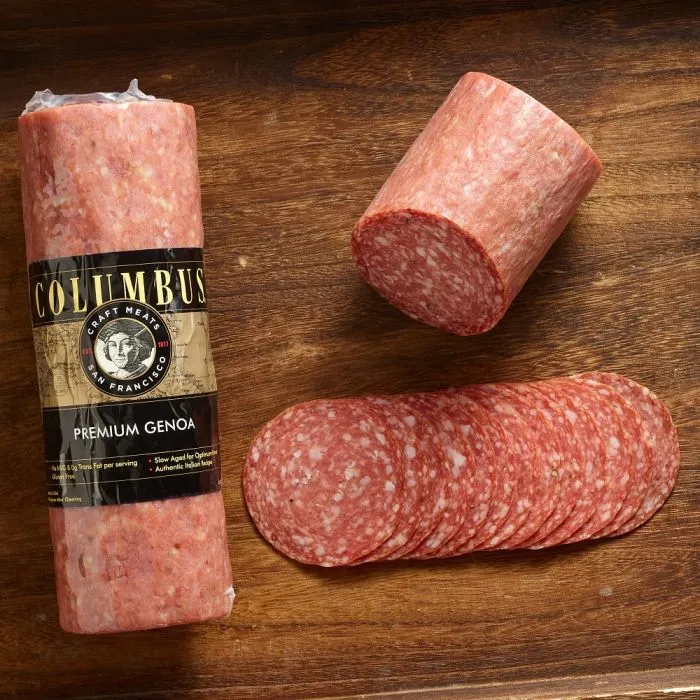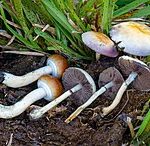Introduction of Genoa Salami
Genoa salami holds a significant place in the food industry, particularly within the context of cured meats and the broader world of charcuterie.
While this article might not reach, I will provide a detailed exploration of Genoa salami’s history, production methods, cultural importance, and its impact on both the culinary world and food industry at large.
What is Genoa Salami?
Genoa salami is a type of Italian dry-cured sausage known for its rich flavor, distinct texture, and use of high-quality pork. It originated in Italy, specifically from the region around Genoa, and is a staple in Italian cuisine and beyond. Genoa salami is typically made from finely ground pork and is flavored with various seasonings, including garlic, salt, pepper, sugar, and wine. The inclusion of fat within the meat mixture is a key characteristic, contributing to the sausage’s smooth texture and moistness.
The salami is often left to cure for several weeks, allowing the flavors to develop fully while the sausage undergoes a fermentation process. This gives Genoa salami its characteristic tanginess, which comes from the natural fermentation of lactic acid bacteria. The end result is a balanced, flavorful sausage that pairs well with a wide range of foods, making it a popular choice in sandwiches, charcuterie boards, and as a topping for pizzas.
History of Genoa Salami
The history of Genoa salami can be traced back to the region around Genoa, Italy, which is located in the northwestern part of the country. Italy has a long tradition of cured meats, many of which date back to ancient Roman times. However, the modern form of Genoa salami as we know it today became particularly popular in the 19th and 20th centuries, when Italian immigrants brought their culinary traditions with them to other parts of the world, especially to the United States.
In Genoa, the salami was often made by small-scale artisans who would cure meats in their cellars or workshops. The recipes used varied from family to family, and each iteration of Genoa salami had its own unique flavor profile. Over time, commercial production methods emerged to meet the growing demand for this beloved sausage, leading to the mass production of Genoa salami for consumers worldwide.
Key Characteristics of Genoa Salami
Several characteristics set Genoa salami apart from other types of salami, both in terms of flavor and production method:
Meat Composition: Genoa salami is typically made with a mix of pork and pork fat. Unlike other varieties of salami that may use beef or other meats, Genoa salami’s use of pork creates a distinct texture and flavor that is recognized worldwide. The amount of fat used can vary, but it’s crucial to the sausage’s smooth, creamy texture.
Seasoning: The seasoning used in Genoa salami is crucial to its flavor profile. Typical ingredients include garlic, black pepper, white pepper, wine (often red wine), and sometimes a small amount of sugar. The wine not only adds to the taste but also aids in the fermentation process, which contributes to the sausage’s characteristic tang.
Curing Process:
Genoa salami is a dry-cured sausage, meaning that it is salted and left to air dry over time. This curing process allows the sausage to develop deep, complex flavors while preserving it for long-term storage. The salami is often hung in a cool, dry place for several weeks to months, depending on the size of the sausage and the desired level of dryness.
Texture: Genoa salami’s texture is smooth and somewhat soft, making it easier to slice and eat compared to some other dry-cured sausages that might be more firm or crumbly. This is due in part to the high fat content, which helps the sausage retain moisture even after it has dried.
Appearance: The visual appeal of Genoa salami is also distinctive. It typically has a marbled appearance with pinkish-red lean meat mixed with white fat throughout the sausage. The casing is usually a natural hog casing, and the salami is often coated in a layer of white mold, which is harmless and a byproduct of the curing process.
Production Methods of Genoa Salami
The production of Genoa salami involves several key steps that blend traditional craftsmanship with modern food safety techniques. The steps can be broken down as follows:
1. Preparation of Meat:
Pork shoulder or other cuts of pork are typically selected for Genoa salami. The meat is finely ground, often through a combination of a coarse grind for the fat and a fine grind for the lean meat. This combination of textures creates the signature smooth and slightly grainy texture of Genoa salami. The fat is a crucial component, typically making up about 30 to 40% of the final product.
2. Mixing with Spices:
After the meat is ground, it is mixed with seasonings. This can include a variety of spices, but garlic, black pepper, and wine are the most common additions. The choice of wine is important, as it can contribute both flavor and moisture to the sausage. The mixture is thoroughly kneaded to ensure the spices are evenly distributed throughout the meat.
3. Stuffing into Casings:
The meat mixture is then stuffed into natural hog casings, which help maintain the salami’s shape during the curing process. The casings are often tied off at both ends to create individual sausages. The sausages are then left to cure, sometimes at a controlled temperature and humidity level to ensure consistent drying.
4. Curing and Fermentation:
The sausages are hung in a cool, dry environment, where they undergo a natural fermentation process. During this time, beneficial bacteria naturally present in the meat begin to convert sugars into lactic acid, which lowers the pH of the salami and contributes to its tangy flavor. The curing process also helps preserve the sausage, giving it a long shelf life. The length of the curing time can vary, but it typically lasts from a few weeks to a few months.
5. Quality Control:
Quality control is essential during the production of Genoa salami to ensure that the final product is safe to eat and meets the desired flavor profile. This includes monitoring temperature, humidity, and the growth of mold. As the sausage cures, it’s important to check for any signs of spoilage or contamination.
Genoa Salami in the Food Industry
Genoa salami holds a strong presence in the food industry, especially within the deli meat and charcuterie sectors. Its role can be categorized into several key areas:
1. Culinary Versatility:
Genoa salami’s versatility is one of the primary reasons for its popularity. It can be enjoyed on its own, as part of a charcuterie platter, or used as a topping for sandwiches and pizzas. Its smooth texture and rich flavor make it a crowd-pleaser in a wide range of dishes, and its ability to pair well with cheeses, fruits, and breads further boosts its culinary appeal.
2. Cultural Significance:
As an Italian product, Genoa salami carries cultural significance within Italian cuisine and Italian-American food traditions. It’s a prominent ingredient in the Mediterranean diet, which emphasizes fresh, high-quality ingredients like cured meats, cheeses, and vegetables. In the U.S., Italian immigrants helped popularize Genoa salami, and it remains a fixture in Italian-American delicatessens, serving as a symbol of Italian culinary heritage.
3. Charcuterie and Specialty Foods:
Genoa salami plays a significant role in the growing charcuterie trend. Charcuterie boards have become increasingly popular in restaurants, food markets, and social gatherings. Genoa salami, with its complex flavors and textures, is a key ingredient in these boards, often paired with a variety of cheeses, olives, and fresh fruits. Its inclusion elevates the overall dining experience and showcases the craftsmanship behind traditional cured meats.
4. Economic Impact:
On a larger scale, Genoa salami contributes to the global food industry by driving the demand for pork and other ingredients used in its production. Cured meats like Genoa salami are sold in supermarkets, specialty food stores, and delis around the world, providing a profitable niche for food producers. Additionally, the production of Genoa-salami supports the livelihoods of artisans, butchers, and food industry professionals involved in the curing and distribution process.
5. Innovation and Modern Variations:
While traditional Genoa salami remains beloved by consumers, the food industry has seen some innovation in recent years. Modern variations of Genoa salami may include different meats (such as beef or turkey), reduced fat content, or the addition of unique spices to appeal to evolving consumer tastes. These innovations have allowed Genoa salami to remain relevant in an increasingly health-conscious food market while still retaining the essence of the traditional product.
Conclusion
Genoa salami is not just a tasty and versatile cured meat; it is also an essential part of the food industry, with cultural, culinary, and economic significance. Its rich history, distinctive production process, and widespread popularity have cemented its place in the pantheon of iconic food products. From its humble origins in Italy to its place in modern charcuterie, Genoa-salami continues to thrive in a competitive market, offering consumers a taste of tradition, craftsmanship, and flavor that transcends borders.
Though modern mass production has made Genoa-salami accessible to people around the world, its roots in artisanal craftsmanship and quality ingredients continue to shape its reputation as one of the finest dry-cured sausages available. As the world becomes increasingly interested in food culture, sustainability, and authenticity, Genoa salami is likely to remain a beloved fixture on the table for years to come.





